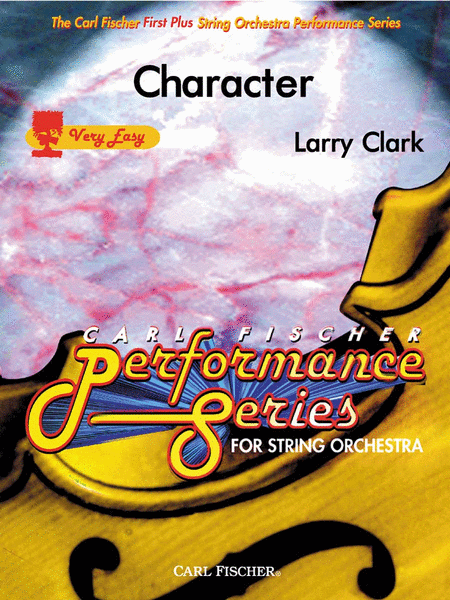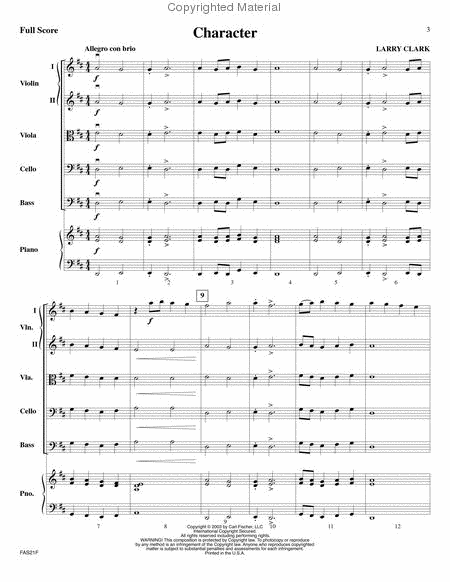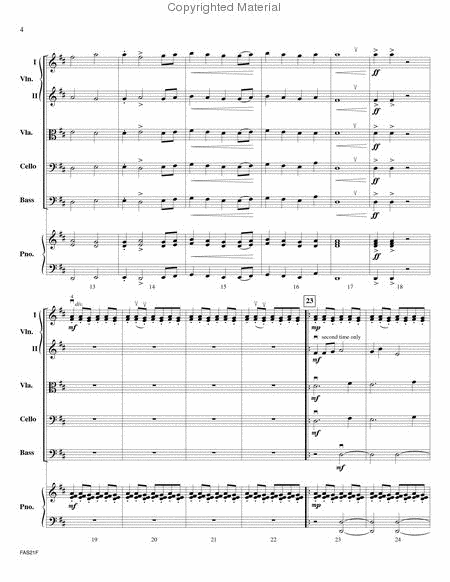Character
-
Ships in 1 to 2 weeks
Details
Description
SKU: CF.FAS21
Composed by Larry Clark. Edited by Amy Rosen. SWS - FS. Carl Fischer First Plus String Orchestra Series. Classical. Score and Parts. With Standard notation. 8+8+2+5+5+5+2+8 pages. Carl Fischer Music #FAS21. Published by Carl Fischer Music (CF.FAS21).ISBN 9780825853067. UPC: 798408053062. 8.5 X 11 inches. Key: B minor.
Character was composed to introduce young string players to contemporary harmonic techniques while still being within the technical limitations of the developing student. Quartal and quintal harmonies open the composition with a fanfare gesture that ties the piece together. This is followed by an ostinato in the first violins that contains a tricky figuration between G and A that will work the pinky finger on the D-string. Players who are not capable of maneuvering their pinky at this brisk tempo should play the lower part. The main theme is given to the inner voice for a change! After the main theme there is a development section that combines fragments of the fanfare material with fragments of the main theme. A grand pause and then a stronger statement of the main theme then follow this with the first violins up an octave. The piece is then completed with a short coda containing fragments of the ostinato and fanfare material. It feels natural for the tempo to speed up slightly at this point in the piece. As with all of my pieces at this level, the tempo is merely a suggestion and should be adjusted slower or faster to fit the needs of your students and the performance situation. It has been my pleasure to have the opportunity to write this piece. I hope you and your students enjoy it and find it useful for your program. -Larry Clark New York, NY 2003.
Character was composed to introduce young string players to contemporary harmonic techniques while still being within the technical limitations of the developing student. Quartal and quintal harmonies open the composition with a fanfare gesture that ties the piece together. This is followed by an ostinato in the first violins that contains a tricky figuration between G and A that will work the pinky finger on the D-string. Players who are not capable of maneuvering their pinky at this brisk tempo should play the lower part. The main theme is given to the inner voice for a change! After the main theme there is a development section that combines fragments of the fanfare material with fragments of the main theme. A grand pause and then a stronger statement of the main theme then follow this with the first violins up an octave. The piece is then completed with a short coda containing fragments of the ostinato and fanfare material. It feels natural for the tempo to speed up slightly at this point in the piece. As with all of my pieces at this level, the tempo is merely a suggestion and should be adjusted slower or faster to fit the needs of your students and the performance situation. It has been my pleasure to have the opportunity to write this piece. I hope you and your students enjoy it and find it useful for your program. -Larry Clark New York, NY 2003.
Character was composed to introduce young string players to contemporary harmonic techniques while still being within the technical limitations of the developing student. Quartal and quintal harmonies open the composition with a fanfare gesture that ties the piece together. This is followed by an ostinato in the first violins that contains a tricky figuration between G and A that will work the pinky finger on the D-string. Players who are not capable of maneuvering their pinky at this brisk tempo should play the lower part. The main theme is given to the inner voice for a change! After the main theme there is a development section that combines fragments of the fanfare material with fragments of the main theme. A grand pause and then a stronger statement of the main theme then follow this with the first violins up an octave. The piece is then completed with a short coda containing fragments of the ostinato and fanfare material. It feels natural for the tempo to speed up slightly at this point in the piece.As with all of my pieces at this level, the tempo is merely a suggestion and should be adjusted slower or faster to fit the needs of your students and the performance situation.It has been my pleasure to have the opportunity to write this piece. I hope you and your students enjoy it and find it useful for your program.-Larry ClarkNew York, NY 2003.



 Share
Share